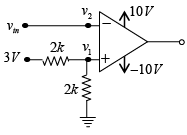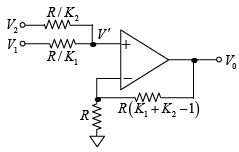Operational Amplifier - Assignment | Solid State Physics, Devices & Electronics PDF Download
Q.1. (a) An op-amp has CMRR = 100dB , differential gain AD = 5 and common mode voltage applied to it is 3 mV . Find the value of common mode output voltage.
(b) An op-amp has differential gain AD = 100 . Common mode voltage applied to it is 3 mV and corresponding output voltage is 0.03 μV . Find the value of CMRR in dB.
(a) CMRR(in dB) = 20log10(AD/ACM)
∵ ACM = VoCM/VCM = 5 x 10-5 ⇒VoCM = 5 x 10-5 x 3 x 10-3V = 15 x 10-8V = 0.15μV
Q.2. Consider the circuit shown in figure below.
 (a) Find the frequency above which the gain will decrease by 20 dB per decade.
(a) Find the frequency above which the gain will decrease by 20 dB per decade.
(b) Find the magnitude of gain at operating frequency of 40 kHz.
(c) Find the phase angle (∅) at 40 kHz.
Q.3. For the circuit shown in figure draw output waveform.
(a)
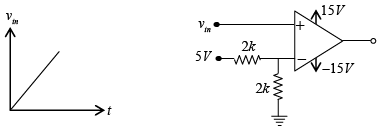
(b)
vid = v1 - v2 = vin - 2.5V ∵
∵ vin < 2.5V ⇒ vid = -ve
∵ vin > 2.5V ⇒ vid = +ve
(b)
Q.4. Consider the circuit shown in figure below.
 (a) Find the frequency above which the gain will decrease by 40 dB per decade.
(a) Find the frequency above which the gain will decrease by 40 dB per decade.
(b) Find the magnitude of gain at operating frequency of 20 kHz.
Q.5. An amplifier has a voltage gain of 500, input impedance 20 kΩ, output impedance 75 Ω and bandwidth is 10 Hz without any feedback. Now a negative feedback with β = 0.1 is applied. Find
(a) Its gain
(b) Input impedance
(c) Output impedance
(d) Its bandwidth
(b) RiF = Ri (1 + AB) = 20k x (1 + 500 x 0.1) = 1020kΩ
(c) RoF = R0/(1+AB) = 75/(1 + 500 x 0.1) = 1.5Ω
(d) foF = f0(1+AB) = 10(1 + 500 x 0.1) = 510Hz
Q.6. Consider the circuit shown in figure below.

(a) Find the frequency upto which the gain will increase by 20 dB per decade.
(b) Find the magnitude of gain at operating frequency 4 kHz and 6 kHz.
(c) Find the phase angle (∅) at 6 kHz.
At 4kHz,
At 6kHz,
(c)
Q.7. Find the output voltage V0 of the OPAMP circuit shown in figure below
(b)
⇒ V0 = 8V
(b)
⇒ V0 = K1V1 + K2V2
Q.8. Consider the circuit shown in figure below.

(a) Find the frequency upto which the gain will increase by 40 dB per decade.
(b) Find the magnitude of gain at operating frequency of 2 kHz.
Q.9. In an ideal Op-Amp circuit shown below Vi = Vm sinωt.
(a) Find the amplitude of V0.
(b) Find the peak value of current through R1.
(c) Find the peak value of current through R2 .
(c) Find the peak value of potential at P.

(b) Current through R1 is
Peak value of current = Vm/R2
(c) Current through R2 is
Peak value of current = Vm/R2
(d) Peak value of voltage at P is = Vm.
Q.10. The input to a lock-in amplifier has the form Vi(t) = Vi sin(ωt+60) where Vi, ω and 600 are the amplitude, frequency and phase of the input signal respectively. This signal is multiplied by a reference signal of the same frequency ω, amplitude Vr and phase 300.
(a) If the multiplied signal is fed to a high pass filter of cut-off frequency ω, find the final output signal.
(a) If the multiplied signal is fed to a low pass filter of cut-off frequency ω, find the final output signal.
(b) If the multiplied signal is fed to a High pass filter of cut-off frequency ω, find the final output signal.
V = Vrsin(ωt+30) x Visin(ωt+60) = ViVr/2[cos(60-30) -cos(2ωt+60+30)]
(a) Output of Low pass filter
(b) Output of high pass filter
Q.11. For the circuit shown in figure the output is Vo = -2V1 +3V2 - V3. Find the values of resistances R1, R2 and R3.
⇒ Vo = -2V1 + 3V2 - V3
Thus R1 = 3kΩ, R2 = 2kΩ and R3 = 6kΩ.
Q.12. Consider a Low Pass (LP) and a High Pass (HP) filter with cut-off frequencies fLP and fHP, respectively, connected in series or in parallel configurations as shown in the Figures A and B below.


Find the response of Filter A and B if
(a) fHP < FLP (b) fHP > fLP
(a) fHP < FLP
A acts as a Band Pass filter, B allows the signal from passing through
(b) fHP > fLP
A stops the signal from passing through, B acts as a Band Reject filter
Q.13. For the circuit shown in figure R1 = R2 = R3 = 2Ω, L = 1μH and C = 1μF . If the input is vin = cos(106t), then |v0/vin| is

Output of first Op-Amp is
Output of second Op-Amp is
Q.14. Consider the Op-Amp circuit shown in figure.
If Vi = V1sin(ωt) and V0 = V2 sin(ωt + ∅), then find
(a) magnitude of the gain
(b) the phase angle (∅) at ω → 0 and w → ∞.
Thus ∅ = -2tan-1(ωRC).
(a) Magnitude of the gain is 1.
(b) The phase angle (∅) at w → 0 is ∅ = 0 and at ω → ∞ is ∅ = -π.
Q.15. In the op-amp circuit shown in the figure, Vi is a sinusoidal input signal of frequency 10 Hz and Vo is the output signal.
(a) Find the magnitude of the gain.
(b) Find the phase of the output signal.


(b) Phase of the output signal ∅ = π - θ = π - tan-1 (ωCRF)
θ = tan-1 (2 x 3.14 x 10 x 10-8 x 104) = tan-1 (6.28 x 10-3) ≈ 0
⇒ ∅ = π - θ ≈ π
Q.16. The circuit in figure employs positive feedback and is intended to generate sinusoidal oscillation. If at a frequency  then to sustain oscillation at this frequency find R2.
then to sustain oscillation at this frequency find R2.

Apply KCL at node 1
Q.17. Figure shows a practical integrator with RS = 30MΩ, RF = 20MΩ and CF = 0.1μF. If a step (dc) voltage of +3V is applied as input for 0 ≤ t ≤ 4 (t is in seconds), then draw output voltage as a function of input voltage.
⇒ V0 = -t Volts
A ramp function of peak voltage -4V.
Q.18. For the circuit in shown in figure below find output frequency frequency f0 and resistance RF.
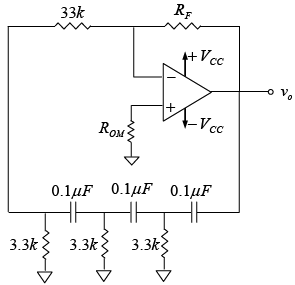
The circuit shown in figure is Phase Shift Oscillator.
The frequency of oscillation f0 and is given by
At this frequency, the gain Au must be at least 29. That is,
⇒ RF = 957kΩ
Q.19. In the Op-Amp circuit shown, assume that the diode current follows the equation I = I0exp(V/VT). For Vi = 2V, V0 = V01 and for Vi = 8V, Vo = V02. At room temperature of 270 C find the value of (V01-V02).

At room temperature of 270C, VT = 26mV
⇒ V01 - V02 = 2VT ln 2 = 2 x 26 x 0.693mV ≈ 36mV
Q.20. For the circuit in shown in figure below if output frequency frequency f0 = 965Hz find R and RF.
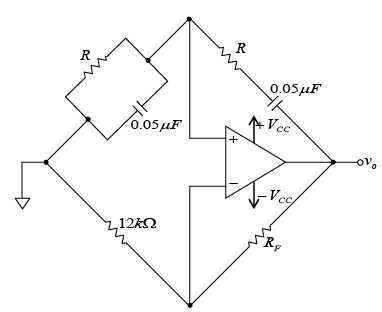
The circuit shown in figure is Wein Bridge Oscillator.
At this frequency RF = 2R1 = 2 x 12 = 24kΩ
Q.21. Consider the following circuit
 Draw output Vout corresponding to the input Vin.
Draw output Vout corresponding to the input Vin.

It’s a inverting comparator with positive feedback. Output is forced to operate in saturation region.
Q.22. The OP-AMP circuit shown in figure is a bistable multivibrator. Let the OP-AMP saturation voltages be ±10V, C = 0.01 µF, R1 = 200kΩ, R2 = 2MΩ and R = 2MΩ.
(a) Calculate the positive and negative threshold voltage at the inverting terminal for which the multi-vibrator will switch to other state.
(b) Calculate the frequency of the oscillation. Sketch the voltage (VOUT) waveform.
(a) Threshold voltage
(b) The time period T of the output waveforms is given by
|
91 videos|21 docs|25 tests
|
FAQs on Operational Amplifier - Assignment - Solid State Physics, Devices & Electronics
| 1. What is an operational amplifier and how does it work? |  |
| 2. What are the key characteristics of an operational amplifier? |  |
| 3. What are some common applications of operational amplifiers? |  |
| 4. What is the ideal behavior of an operational amplifier? |  |
| 5. What are some limitations of operational amplifiers in real-world applications? |  |







